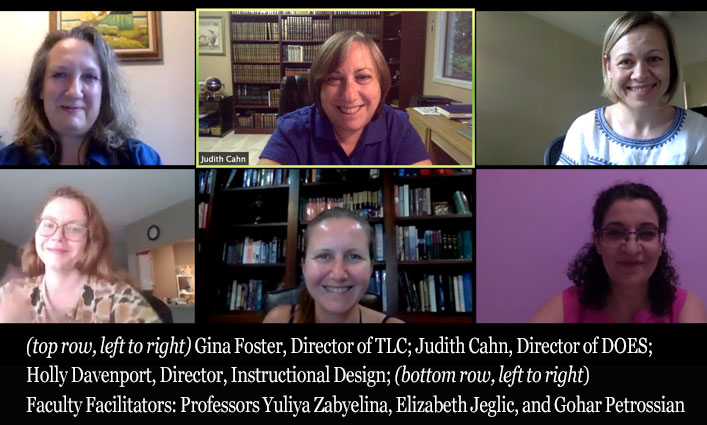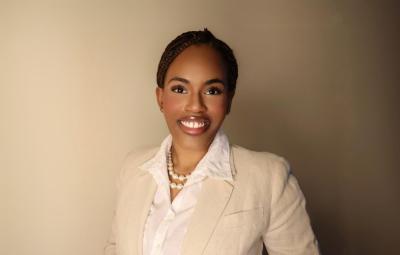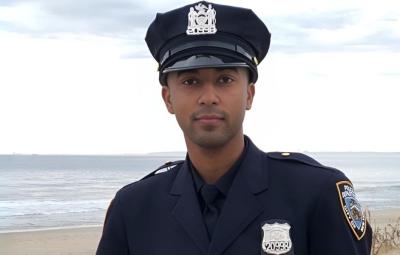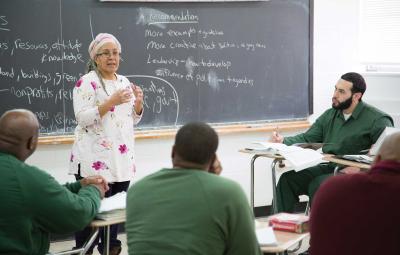
When the Covid-19 health crisis forced classrooms to go from in-person to online this past spring, students and faculty alike worked fast to transition to a distance-learning model—an environment that was new to many. Taking the lessons learned from Spring 2020 to heart, John Jay has created the Effective Practices for Online Teaching Workshop, an innovative teaching workshop that enhances our faculty’s ability to effectively teach online and increase student success. Understanding that learning in the classroom differs greatly from learning in a virtual environment, the three-week workshop teaches faculty how to adapt their lessons to a virtual setting, by designing easy-to-navigate courses with clear expectations for students. Using the latest best practices for online teaching and learning, faculty are incorporating different tools and methodologies, such as videos, participating in synchronous group discussions, and increasing flexibility so students can do the work on their own time, enabling them to engage more with the material and excel as virtual learners.
Launched in May, the Effective Practices for Online Teaching Workshop is partially funded by a grant from the National Endowment for the Humanities, awarded to Allison Pease, Ph.D., Associate Provost for Institutional Effectiveness and Professor of English, to create effective online humanities courses during the Covid-19 crisis. “At John Jay, we are training 340 plus faculty in the Effective Practices for Online Teaching Workshop, facilitated by John Jay faculty who are experts at teaching online,” says Pease, adding that faculty in over 27 departments have enrolled in the workshop. “It’s a massive effort to ensure we are ready to deliver an outstanding educational experience in the fall.”
“At John Jay, we are training 340 plus faculty in the Effective Practices for Online Teaching Workshop. It’s a massive effort to ensure we are ready to deliver an outstanding educational experience in the fall.” —Allison Pease
Now in its third month, the professional development opportunity is already receiving positive feedback, with one faculty member noting how the workshop helped him understand the difference between traditional and online teaching. “As the course progressed it was obvious that simply transposing my material to distance learning wasn’t going to be enough,” a faculty member reported after finishing the workshop. “Discussion board activities, smaller summative assessments such as short quizzes, as well as numerous online links to readings were now the smartest ways to engage my students.”
To learn more about the Effective Practices for Online Teaching Workshop and its transformative impact on our faculty, we sat down with Gina Foster, Director of the Teaching and Learning Center (TLC), and Judith Cahn, Director of Department of Online Education and Support (DOES), who are spearheading the workshop effort. They share how faculty are working collaboratively and deepening their online teaching skills in order to better deliver the highest quality education to our John Jay students.
How did the Effective Practices for Online Teaching workshop become a reality?
Cahn: The CUNY School of Professional Studies (SPS) has a three-week workshop to help faculty across the entire university system enhance their online teaching skills. At John Jay, we knew SPS was going to have a high demand when Covid-19 hit—faculty from 27 Colleges all wanting training is a lot—so we began thinking how we as a College could help our faculty and help lift some of that stress off of SPS. One of the things we thought of was doing our own workshops. We already had the infrastructure in place in order to train faculty and get them up to speed. We’ve collaboratively done this before. In my department, the Department of Online Education and Support, the instructional design team, led by Holly Davenport, and I worked on developing the Effective Practices for Online Teaching Workshop, with Gina Foster’s input and eyes on it. We took that wisdom from TLC and tapped faculty who are experienced in online teaching—we call them our superstars in online teaching—to facilitate these workshops, so it’s faculty teaching faculty.
What is the structure of the workshop and who are the superstar facilitators?
Cahn: We’ve been doing the workshop since May. It’s the same three-week workshop, with one workshop a month, and each workshop divided into four sections (cohorts). We have four faculty facilitators: Al Coppola, Ph.D., Associate Professor of English; Elizabeth Jeglic, Ph.D., Professor of Psychology; Gohar Petrossian, Ph.D., Assistant Professor of Criminal Justice; and Yuilya Zabyelina, Ph.D., Assistant Professor of Political Science.
“Nobody is being left abandoned to do this alone, there’s always support.” —Judith Cahn
We’re covering a lot of things in three weeks. We wanted to balance the experience of being an online student with the experience of being a professor building an online course. We also had to balance how much we are teaching about the online learning environment—this includes online pedagogy—and the learning management system (LMS), which is Blackboard and how to actually build your course on the platform. The way we managed these two variables is that in the workshop, faculty are learning about online teaching and learning, and they’re also putting what they’re learning into practice by participating in online discussions and other online activities. The faculty each get their own shell of a course which they then get to build. So, they’re working in two different environments—the environment of the workshop and the environment of their developmental course.

After completing the workshop, is there additional support available to faculty?
Cahn: Absolutely. First, the facilitators have been wonderful in supporting faculty after they’ve completed the workshop. We’ve also given faculty access to the workshop once it’s completed and they have numerous resources at the College, including the Department for Online Education website, access to the webinar recordings, and an e-learning webpage where they can schedule one-on-one time with an instructional designer. There’s also Blackboard help. Nobody is being left abandoned to do this alone, there’s always support.
Foster: One of the things Judy and I wanted was discipline-friendly cohorts within each 80-person workshop. There are four cohorts in each workshop, each includes a group of 20 faculty from a similar field. We don’t want them to be so far apart in field that they can’t support each other or understand what they’re doing. Each of the workshop sections are to be led by someone who is discipline-friendly—we have the Humanities, the Social Sciences, the Applied Sciences, and the Hard Sciences. A great result of doing the workshop this way is that we’re building communities of practice within departments at the College, and then the follow-up can happen within those departments. That partners well with the other resources offered, because beyond the help from DOES, TLC, and Blackboard, you have this additional support from people who have gone through the workshop with you. And there can be this back and forth, where they talk about how they’re using Blackboard, how they’re putting their course together, and how they’re working through issues. That added level of community support helps.
“A great result of doing the workshop is that we’re building communities of practice within departments at the College.” —Gina Foster
What are some of the additional advantages of building these communities within the workshop?
Foster: Our workshop is John Jay focused. We’re looking at what will work in Blackboard, and any external tools, as well as who the people are who are going to make the teaching work for John Jay. These communities help create consistency across departments. For instance, in the English department we have 100- and 200-level classes. In the department, they’re developing common templates in Blackboard so that everyone who teaches those courses online can go in and find what they need to construct a consistent, but also individualized, course to teach.
Cahn: It gives them a foundation from which to build. We’re building communities of practice and capacity within the departments. We’re also trying to foster self-advocacy amongst faculty. They know they can do it. They know the people within their department and they can partner with their colleagues. It’s been a tremendous collaborative effort.
“Faculty at John Jay have been inspirational. They’re really trying to stay connected to the students, and keep the students connected to the College.” —Judith Cahn
At the start of the Spring 2020 transition to a distance-learning model, what were some of the things you experienced while guiding faculty members?
Cahn: Faculty who were completely new to online teaching, who had been teaching for 40 years and never touched anything digital, they wanted to just take what they did in the classroom and do it remotely. But you can’t do that. We worked with them to adapt. There was one professor who was very nervous. We walked her through Zoom and she learned how to get the recording and the transcription of the recording–which was important because she had a student who was hearing impaired. That was such a game changer for her. I find that faculty at John Jay have been inspirational. They’re really trying to stay connected to the students, and keep the students connected to the College.
Foster: Everyone had some type of technical issue at one point or another, too. Whether it was not having the right equipment or having outdated software. Some faculty didn’t have the basic Blackboard skills that are needed online, which they’re getting now. I also got many emails from faculty concerned about their students. That’s why many increased their online-teaching skills and are going on to learn how to work online better in ways that are sustainable through the workshop. The community of faculty we’ve developed at John Jay is extraordinary. The opportunities we have to change higher education for our students are ones we’ve really started to build on.
“What this workshop has shown me is how deeply committed John Jay faculty are to the College’s mission and to our students.” —Gina Foster
What were some of the takeaways, or lessons learned, from the Spring 2020 semester?
Cahn: We now have more discussion about synchronous (learning in real time) vs. asynchronous (no fixed time) type of learning. One of the things we’ve often said is that you don’t have to give up synchronous learning. It’s important that students stay connected, but they can use synchronous time differently. So, let’s say you’re using a combination of synchronous and asynchronous—you have something on Blackboard, you have videos, and readings—then you can come together as a class to have a conversation, to have the interactions. Students can work as a group using synchronous sessions. It makes for a different type of course and gives it a different feel.
Foster: What this workshop has shown me is how deeply committed John Jay faculty are to the College’s mission and to our students. They see the workshop as an opportunity to make distance learning work. It’s a beautiful way to see how much faculty want this, how invested they are in their students, and how eager they are to make things work.
Cahn: And, the fact that they can create something online and offer not only a quality education, but also flexibility, is really a powerful testament to their commitment to students. The flexibility allows students to engage with the course when they can. During these difficult times, everyone is dealing with something—whether its child care issues, health issues, or work issues. Whatever it is, the fact that students can still participate in learning online and access the material when they can, and when they need to, is tremendous.
What would you say are the three key ingredients needed for a fantastic online class?
Foster: First, you need a great and clear design. Second, the facilitator or instructor has to be prepared, engaging, and welcoming. And third, there needs to be a shared sense of commitment and urgency to being present and engaged in doing the work.
Cahn: Like Gina said, clarity in the design of the course is a big piece of it. We emphasize to faculty that they need to give specific directions and set clear expectations so students know what is expected of them—and vice versa, because it’s a community, and students should also know what to expect from a professor. And, that shared commitment Gina mentioned, is a sense of community. Everyone is engaged—whether you’re doing group learning or responding to discussions—keeping the conversation going so people know we’re all in this together.
“Faculty will be more comfortable navigating Blackboard, and that translates to a better Blackboard experience for students.” —Judith Cahn
Come the Fall 2020 semester, what differences will students notice in their online classes?
Cahn: One thing they’ll notice is that the faculty will be more comfortable navigating Blackboard, and that translates to a better Blackboard experience for students. There will be increased communication because the instructor will be more present in the course on Blackboard. Also, the structure and organization will be much clearer and that comes with understanding how a course should be laid out online. Students will be able to navigate their way through the material much easier.
Foster: They’ll also notice that most of the faculty will have video introductions. These videos will be warm and professional, and they’ll guide students through the syllabus and the course. Students will also find that when they get on the discussion boards, they will be getting more engaged responses, they’re going to feel that instructor’s presence. It’s going to be a warm and welcoming safe place that will let students perform their best.



